News
Brickken CEO Edwin Mata tackles firm’s selection for European Commission’s blockchain, DLT regulatory sandbox
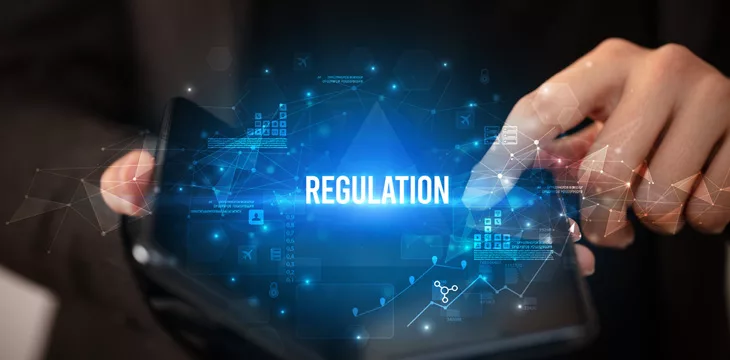
This month, Barcelona-based tech startup Brickken announced its selection to participate in the European Commission’s (EC) European Blockchain and Distributed Ledger Technologies (DLT) Regulatory Sandbox.
The sandbox aims to accelerate the development of blockchain technologies and platforms by putting startups and regulators in pan-European countries in direct contact, to test new products and services in real-life environments.
In its June 13 press release, Brickken stated that its inclusion in the sandbox represented “another milestone in its mission to revolutionize the tokenization industry” and “another step towards the adoption of blockchain by institutional clients, banks, and capital markets.”
CoinGeek caught up with Brickken CEO Edwin Mata to discuss the company, its involvement in the sandbox and what it hopes to achieve in the coming year.
About Brickken
“We are a tokenization platform, what we do is allow companies of any size in any country to be able to tokenize their assets, that is digitize whatever they want, such as real estate, equity, debt,” explains Mata. “We’re in the field of just providing the solution for companies to be able to tokenize themselves.”
Co-founded in Barcelona in 2020 by Mata, Yassir Haouati, Bram Duindam and Dario Lo Buglio, the company’s stated mission is to “empower businesses and individuals to tokenize assets, democratizing investments and revolutionizing asset management,” and its vision is to “create a global ecosystem for accessible digital asset ownership, transforming finance through innovation, transparency, and growth.”
Brickken provides technological support for anyone looking to enter the market without the need to develop their technology, as they can rely on Brickken’s infrastructure, which offers a “frictionless entry.”
Since its 2020 inception, it is now active in over 14 countries. The company has tokenized more than US$200 million in assets and boasts over 50 clients. According to Mata, there has been a recent boom in interest recently.
“Starting November, we saw an uptick because institutional players started talking about tokenization. We had BlackRock (NASDAQ: BLK), we had a tokenized bonds, and various other players entered the field. So that allowed us to really enter the market, because we were already here with a great product and we understand the wave.”
This was reflected in a busy couple of months for the company, which saw it announce in May its selection to participate in PricewaterhouseCoopers’s (PwC) Scale program. Scale aims to assist tokenization and digital asset companies “scale up,” through a rigorous 12-week curriculum that includes masterclasses and personalized mentorship from subject matter experts.
Now Brickken heads into the EC sandbox, and Mata hopes it will usher in further growth.
“We want to test this bond structure. We want to go to the next level – can institutional players use blockchain for funded structuring?”
He goes on to explain that the sandbox is not just about testing products and growing the company; it’s also about increasing cooperation with regulators.
“In a perfect world, I believe we can benefit [from] the connection between the regulator and the private company,” says Mata. “In this sandbox, we’ve got 20 different companies with different 20 different use case, and it’s all about explaining to the regulator what we’re doing day to day… to explore technology and legality with the regulators and also receive feedback.”
This is one of the main goals of the EC’s sandbox, increased transparency and communication between regulator and company.
The regulatory sandbox
The EC, part of the European Union’s executive branch, announced the blockchain regulatory sandbox in 2020 to provide an environment for testing use cases for blockchain tech and digital assets as part of the European Blockchain Services Infrastructure (EBSI).
The aim was to provide legal certainty through facilitating regulatory dialogue and cooperation between innovators and regulators at the national and the EU level.
“DLT [distributed ledger technology] use cases participating in the Sandbox have the opportunity to demonstrate their innovative solutions and highlight their needs regarding regulatory guidance and legal certainty to regulators and supervisors in a safe and confidential environment,” said the EC at the time.
Participants in the sandbox would receive legal advice and be able to develop their regulatory understanding and extend their network and reputation through their participation.
The EC explained that the dialogues would be held “across industry sectors and geographic regions, which will help to identify and communicate best practices in the interest of the wider EU/EEA blockchain community. The sandbox is open to use cases based on any blockchain infrastructure.”
In terms of benefits to regulators and authorities, they would be able to discuss regulatory issues that have arisen on a national level in a cross-border setting with other EU and national regulators making use of the pan-European Sandbox framework that is established for this project. Regulators have the chance to support applications of use-cases for the sandbox that they find particularly relevant for a regulatory dialogue.
The sandbox was set up to host 20 blockchain startups annually, running until 2026. Companies (including start-ups and scale-ups), non-profit organizations and public bodies with a validated proof of concept can apply, with applicants vetted and selected by a team of academic experts from European universities. The EC then matches these companies with the relevant national and European regulators for a “constructive dialogue on the most relevant regulatory issues.”
As the EC put it: “The European Blockchain Sandbox has been set up and is being operated to facilitate the dialogue between regulators and innovators for private and public sector use cases. Legal advice and regulatory guidance will be provided in a safe and confidential environment.”
The sandbox was eventually launched in February 2023, and a few months later, in July, the first cohort of 20 projects were revealed.
The selected projects received regulatory and compliance guidance from a cross-section of European Union regulators based on their industries. The projects cut across several sectors, with transportation, culture, food, education, manufacturing, finance and telecommunications making the bulk of use cases.
Mata explains that the first set of cohorts were, more or less, just dipping their toes into the blockchain space, exploring, for example “a public ledger where you can like really see the transactions and put everything on the ledger.”
By comparison, he argues that this year’s selected 20—which was announced by the EC this month and included Brickken—demonstrates a greater diversity of companies exploring what blockchain can do, and working in areas that serve to greater amplify the potential of blockchain technology.
As well as Brickken—working in the trending area of tokenization of real-world assets—Mata gives the examples of fellow cohorts Hacken, which focuses on smart contract and blockchain security analysis, and DigiShares, which is “trying to get a tokenized real estate secondary market.”
Despite the diversity of projects, there is something all the various cohorts of the EC sandbox share.
“We’re representing the industry. I don’t know how many companies applied, but it’s important for the 20 companies on board to really show transparency to the regulator and tell them ‘we’re doing this in your field, how is going to be treated?’ Because others will come, it’s not like we’ve just inventing some weird sci-fi thing, we’re already in the market,” says Mata.
He goes on to suggest that the sandbox is “the perfect opportunity for the regulator to acknowledge the fact that this is here. It’s not just, ‘oh yeah, I’m going to test this thing now,‘ we’re already making a business out of tokenizing real-world assets, and they have to acknowledge that.”
For Brickken, this is a primary and crucial goal of the sandbox.
MiCA and regulatory uncertainty
The reason increased dialogue, clarity and acknowledgement between regulators and blockchain companies may be necessary, is certain impending regulation in the EU.
Namely, the European Union’s landmark Markets in Crypto Asset regulation (MiCAR), also called MiCA, which passed its final vote in the EU parliament in April 2023 and is gradually coming into force this year.
MiCAR brings digital assets, issuers, and service providers under a broad regulatory framework. Digital asset service providers, such as exchanges and wallet providers, must obtain a license from national regulators to offer services to EU citizens. Along with license mandates, MiCAR will provide new classifications for different digital assets, rules specific to those assets, proof-of-funds requirements for stablecoin issuers, and the requirement for any company seeking to issue digital assets/coins to publish a white paper containing information about the project, including possible risks.
The regulation became law on June 30, 2023, and the new framework will start to apply in two phases: the part of MiCA regulation containing specific rules applicable to stablecoins will start to apply as of June 30, 2024, and rules applicable to digital asset service providers will start to apply as of December 30, 2024.
“Unfortunately, right now, it’s a very messy situation because at the end of June, certain parts of MiCAR come into force, and the second part in December. The first part is around stablecoin, or asset-backed tokens, and we don’t even know which stablecoins and asset-backed are going to require a license,” says Mata.
MiCAR does explain quite clearly which types of assets will fall within its remit and what issuers and custodians of those assets need to be compliant. However, the confusion arises because, despite the looming end-of-June implementation date, it’s not clear if some of the major stablecoins are going to comply with the rules, and therefore, whether EU companies and investors will be able to use them.
“The most tradable asset-backed tokens right now are UST and USDC, and we don’t know if we’re going to be able to use those in Europe,” explains Mata.
UST, or Tether, is the most widely used stablecoin on the market, and USDC, issued by U.S. company Circle, is a close second. Both have signaled their displeasure with MiCAR’s stablecoin rules.
In February, a paper published by Circle criticized the EU approach as flawed, saying it would only push issuers away, while Tether’s CEO Paolo Ardoino stated in an April interview the company’s unwillingness to secure permission to operate under the MiCAR framework.
Despite complaints, Circle has applied for an EU electronic money license (EMI) and is currently awaiting the result. Its CEO, Jeremy Allair, also said that its goal is to bring its products and services into full compliance with the impending MiCA rules. It remains unclear whether the regulation shy Tether will follow suit.
“Just the fact that we don’t even know what we can trade, is going to be reducing the amplitude of what we’re doing on a day-to-day,” says Mata. “The fact that there’s so much uncertainty is definitely going to have a huge impact on the industry. It’s always a concern about legality, but also about innovation. There are countries that are not going to be able to access the top-notch technology, just because they feel like the regulation is overboard. It’s fine, you’ve got to protect the customer, but at the end, you cannot start blocking innovation.”
Arguably, this is where the EC’s regulatory sandbox can come into its own, allowing a space free of regulatory uncertainty for companies to innovate in cooperation and dialogue with regulators.
Brickken’s hopes for the sandbox
“The outcome of all of this has to be best practices. The regulator issued a booklet for best practices recently on last year’s companies, they understood what they were doing, and they flagged issues,” says Mata.
The best practices booklet he refers to is the EC’s best practices report, which examines the progress the sandbox and suggests “best practices” based on observations, feedback and dialogue between participants and regulators.
Part A of the report was published in February and covered the early stages of setting up the sandbox, the first applications phase, the selection of the first cohort, outreach to regulators and the beginning of the first set of dialogues. Part B will likely drop before the end of the summer and will cover the best practices and lessons learned in relation to the first round of regulatory dialogues.
The best practices and observations to come out of the early phases of the sandbox, with the first set of cohorts, included that the setup of the sandbox and application website worked well; there was “great interest from innovators”; and for use cases which incur a range of different regulatory topics, a more in-depth dialogue with specific regulators and authorities appeared to work better.
The EC’s full observations on the dialogue between participant companies and regulators won’t be known until Part B of the report is published, but such productive collaboration on best practices is what Mata and Brickken seek.
“We want to provide information for the regulator, and on everything that happens, but it’s also a challenge for us because we are so deep into the innovation field that we forget or neglect the fact that it’s highly regulated,” says Mata. “We comply with absolutely everything, but this is also our testing phase. We want to put the challenge, to break in and say, we know the game, we have been working at this for years, we have inhouse and external lawyers, we have consultants, we have all of this to leverage the fact that we are compliant.”
Spreading awareness is key for Mata, to regulators but also to the market at large:
“It’s always about how we can spread more awareness, and this has been one of the key priorities of Brickken because we’re always out there publishing, doing interviews, mass media, going to events on blockchain. We’ve already been to six events this year, and we have about 12 more before the end of the year, which is ridiculous!”
One such event was the London Blockchain Conference 2024 (LDNBlockchain24), which took place from May 21 – 23, and at which Mata spoke.
Brickken at the London Blockchain Conference
The annual London Blockchain Conference brought together businesses, academics, developers, innovators, commentors, and blockchain enthusiasts to discuss, learn, and connect on all things blockchain, Web3, artificial intelligence (AI) and regulation.
Mata was part of a panel on tokenizing real-world assets, during which spoke about a move from stablecoins to tokenized treasury bills and financial instruments—something he said was a move along the risk curve.
He also assured attendees of the conference that that regulations will still apply to tokenized assets, reducing the risk of market crash. Tokenization, he explained, is a new way of doing things, but it doesn’t fundamentally change the rules.
In terms of his experience of the London Blockchain Conference 2024 and reasons for attending, Mata says:
“We started in 2020, we have always been educators. So as a business, we still have to create that market, and that’s the biggest challenge. We want to do these kinds of events, where we always find partners, clients, and then on the back of it we try to spread, “the gospel” that blockchain has a lot of different functionalities.”
Mata recalls that his specific panel discussion on tokenization was, “one of the most approached panels… so I would say we had an impact.”
“That impact matters, but it’s also about how we can echo that. I mean, the immediate impact can be that maybe 100 people listened to you. You will then leverage that and amplify it to thousands. We always do that when we attend a conference, for example, on our socials, to spread the word.”
This is the common thread through both Brickken’s participation in the EC regulatory sandbox and attending events such as London Blockchain Conference—to spread the word about the technology and increase transparency, whether that’s with investors or regulators.
Outside of increased dialogue, from a more practical standpoint, through its inclusion in the EC regulatory sandbox Brickken will be able to develop and optimize its solutions within a secure environment, potentially boosting its acceptance among institutional clients, market operators, and bond issuers, as well as facilitating its entry into new markets.
Ultimately, the company aims to become a strategic ally for various capital market players, maximizing their operational efficiency and “fostering technological synergy” in digital asset management.
A goal that Mata believes is closer to reality thanks to the company’s inclusion in the EC sandbox.
“I’m optimistic to find out how much Brickken can grow, through getting ourselves into transparency with the regulator – the issuer of the regulations we’ve been working with,” says Mata.
“Transparency in blockchain matters, so I think it’s a great way to showcase if we can continue in the same way. Are we going to be accepted? Can we keep innovating? Can we keep supplying to the market? It’s a learning curve, even for us.”
Watch BSV DevCon 2024 highlights: Building real-world solutions for real-world problems
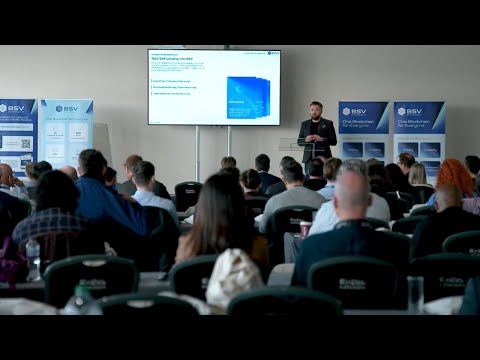
 width=”560″ height=”315″ frameborder=”0″ allowfullscreen=”allowfullscreen”>
width=”560″ height=”315″ frameborder=”0″ allowfullscreen=”allowfullscreen”>
New to blockchain? Check out CoinGeek’s Blockchain for Beginners section, the ultimate resource guide to learn more about blockchain technology.
News
Terra Can’t Catch a Break as Blockchain Gets $6 Million Exploited
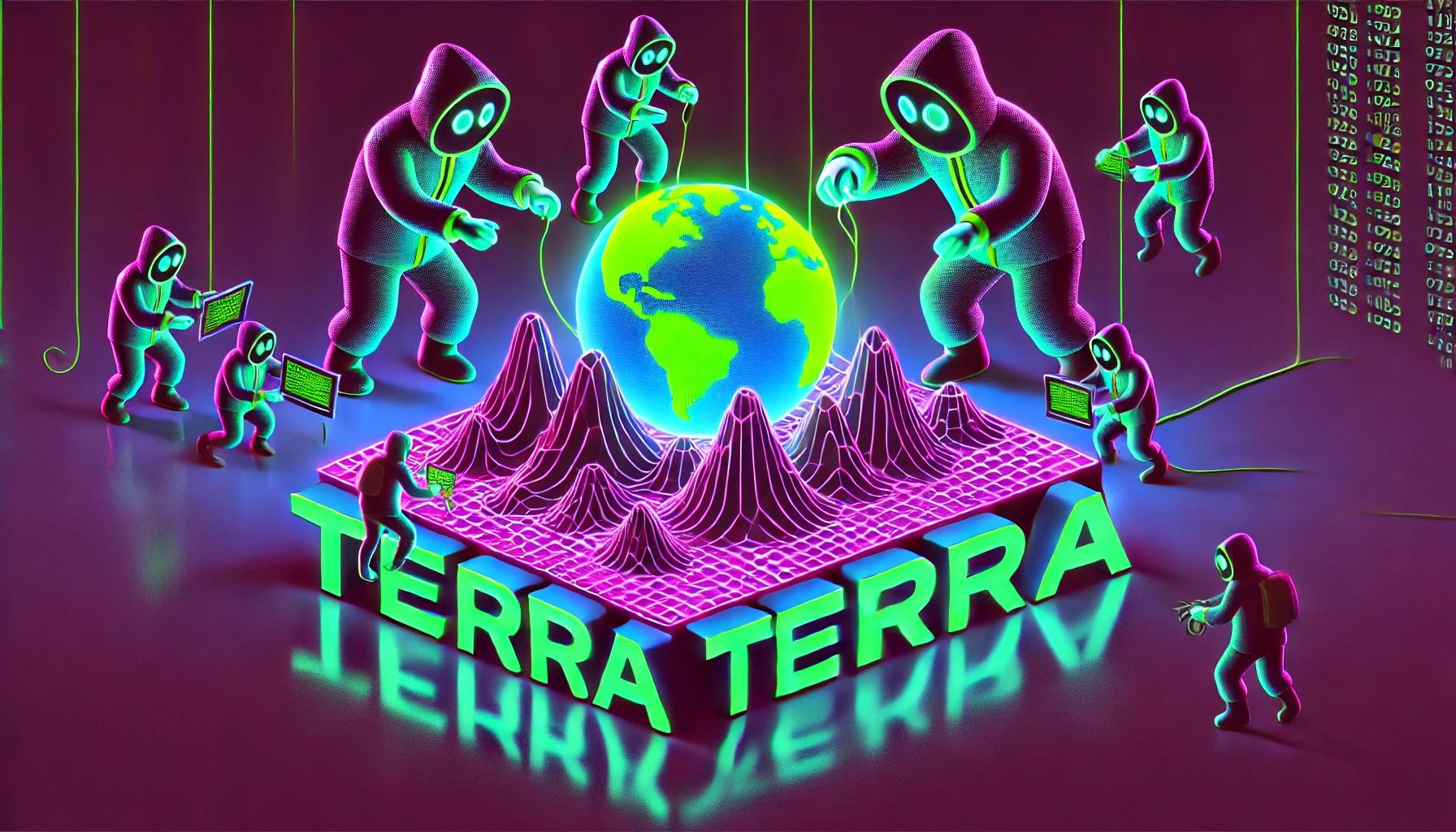
The attack, which exploited a vulnerability disclosed in April, drained around 60 million ASTRO tokens, sending the price plummeting.
The Terra blockchain has been exploited for over $6 million, forcing developers to take a momentary break the chain.
Beosin Cyber Security Company reported that the protocol lost 60 million ASTRO tokens, 3.5 million USDC, 500,000 USDT, and 2.7 BTC or $180,000.
Terra developers paused the chain on Wednesday morning to apply an emergency patch that would address the attack. Moments later, a 67% majority of validators upgraded their nodes and resumed block production.
The ASTRO token has plunged as much as 75%. It is now trading at $0.03, a 25% decline on the day. Traders who took advantage of the drop are now on 195%.
The vulnerability that took down the Cosmos-based blockchain was disclosed in April and involved the deployment of a malicious CosmWasm contract. It opened the door to attacks via what is called an “ibc-hooks callback timeout reentrancy vulnerability,” which is used to invoke contracts and enable cross-chain swaps.
Terra 2.0 also suffered a massive drop in total value locked (TVL) in April, shortly after the vulnerability was discovered. It plunged 80% to $6 million from $30 million in TVL and has since lost nearly half of that value, currently sitting at $3.9 million.
The current Earth chain emerged from the rubble as a hard fork after the original blockchain, now called Terra Classic, collapsed in 2022. Terra collapsed after its algorithmic stablecoin (UST) lost its peg, causing a run on deposits. More than $50 billion of UST’s market cap was wiped out in a matter of days.
Terraform Labs, the company behind the blockchain, has been slowly unravelling its legal woes since its mid-2022 crash. Founder Do Kwon awaits sentencing in Montenegro after he and his company were found liable for $40 billion in customer funds in early April.
On June 12, Terraform Labs settled with the SEC for $4.4 billion, for which the company will pay about $3.59 billion plus interest and a $420 million penalty. Meanwhile, Kwon will pay $204.3 million, including $110 million in restitution, interest and an $80 million penalty, a court filing showed.
News
Google and Coinbase Veterans Raise $5M to Build Icebreaker, Blockchain’s Answer to LinkedIn

Icebreaker: Think LinkedIn but on a Blockchain—announced Wednesday that it has secured $5 million in seed funding. CoinFund led the round, with participation from Accomplice, Anagram, and Legion Capital, among others.
The company, which is valued at $21 million, aims to become the world’s first open-source network for professional connections. Its co-founders, Dan Stone and Jack Dillé, come from Google AND Monetary base; Stone was a product manager at the cryptocurrency giant and also the co-creator of Google’s largest multi-identity measurement and marketing platform, while Dillé was a design manager for Google Working area.
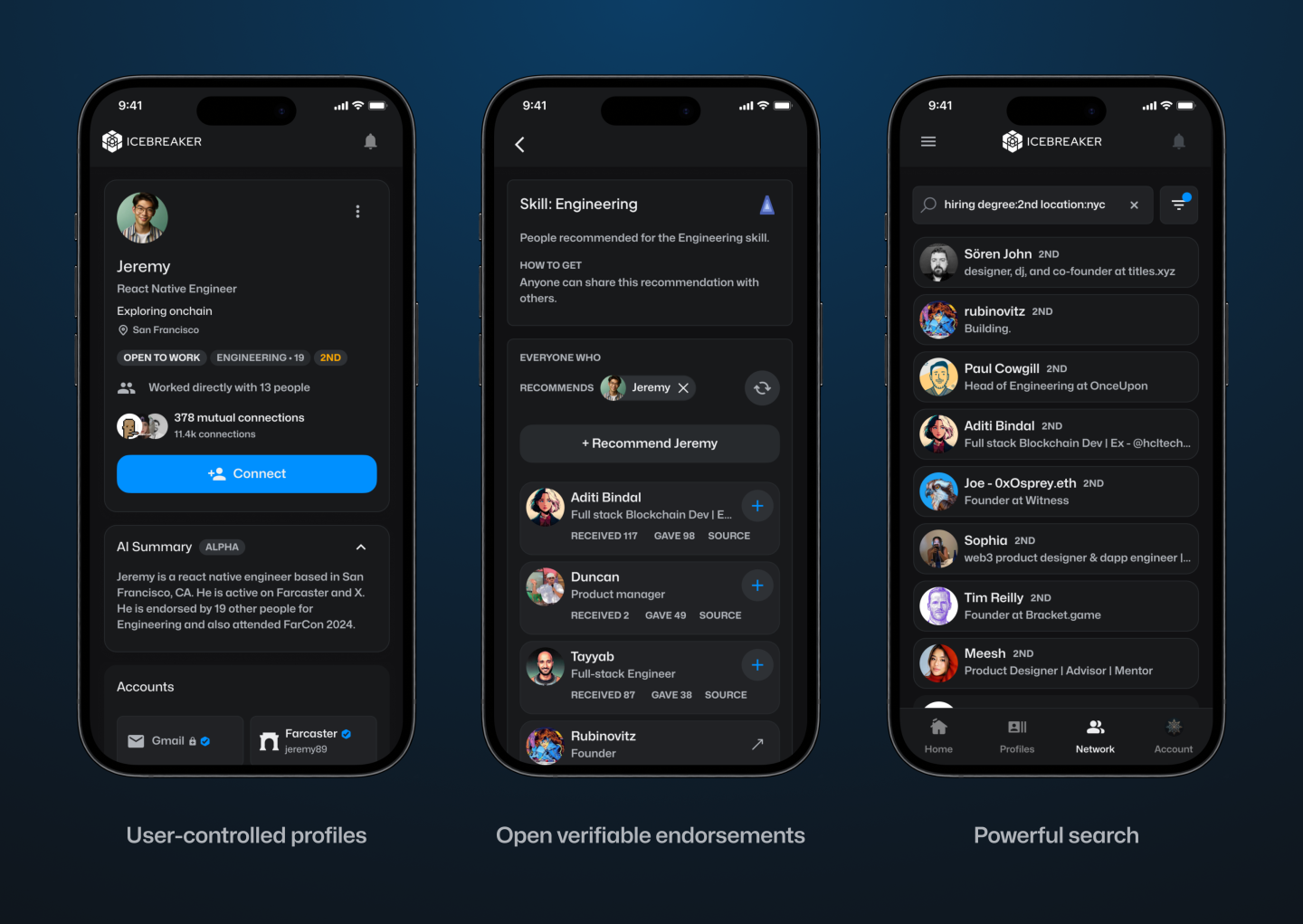
The pair founded Icebreaker on the shared belief that the imprint of one’s digital identity (and reputation) should not be owned by a single entity, but rather publicly owned and accessible to all. Frustrated that platforms like LinkedIn To limit how we leverage our connections, Dillé told Fortune he hopes to remove paywalls and credits, which “force us to pay just to browse our network.” Using blockchain technology, Icebreaker lets users transfer their existing professional profile and network into a single, verified channel.
“Imagine clicking the login button and then seeing your entire network on LinkedIn, ChirpingFarcaster and email? Imagine how many introductions could be routed more effectively if you could see the full picture of how you’re connected to someone,” Stone told Fortune.
Users can instantly prove their credentials and provide verifiable endorsements for people in their network. The idea is to create an “open graph of reputation and identity,” according to the founders. They hope to challenge LinkedIn’s closed network that “secures data,” freeing users to search for candidates and opportunities wherever they are online. By building on-chain, the founders note, they will create a public ledger of shared context and trust.
Verified channels are now launched for
Chirping
Online Guide
Wallet
Discord
Telephone
TeleporterYou can find them in Account -> Linked Accounts Italian: https://t.co/mRDyuWW8O2
— Icebreaker (@icebreaker_xyz) April 3, 2024
“Digital networking is increasingly saturated with noise and AI-driven fake personas,” the founders said in a statement. For example: Dillé’s LinkedIn headline reads “CEO of Google,” a small piece of digital performance art to draw attention to unverifiable information on Web2 social networks that can leave both candidates and recruiters vulnerable to false claims.
“Icebreaker was created to enable professionals to seamlessly tap into their existing profiles and networks to surface exceptional people and opportunities, using recent advances in cryptographically verifiable identity,” the company said, adding that the new funding will go towards expanding its team and developing products.
“One of the next significant use cases for cryptocurrency is the development of fundamental social graphs for applications to leverage… We are proud to support Dan, Jack and their team in their mission to bring true professional identity ownership to everyone online,” said CoinFund CIO Alex Felix in a statement.
Learn more about all things cryptocurrency with short, easy-to-read flashcards. Click here to Fortune’s Crash Course in Cryptocurrency.
Fuente
News
Luxembourg proposes updates to blockchain laws | Insights and resources

On July 24, 2024, the Ministry of Finance proposed Blockchain Bill IVwhich will provide greater flexibility and legal certainty for issuers using Distributed Ledger Technology (DLT). The bill will update three of Luxembourg’s financial laws, the Law of 6 April 2013 on dematerialised securitiesTHE Law of 5 April 1993 on the financial sector and the Law of 23 December 1998 establishing a financial sector supervisory commissionThis bill includes the additional option of a supervisory agent role and the inclusion of equity securities in dematerialized form.
DLT and Luxembourg
DLT is increasingly used in the financial and fund management sector in Luxembourg, offering numerous benefits and transforming various aspects of the industry.
Here are some examples:
- Digital Bonds: Luxembourg has seen multiple digital bond issuances via DLT. For example, the European Investment Bank has issued bonds that are registered, transferred and stored via DLT processes. These bonds are governed by Luxembourg law and registered on proprietary DLT platforms.
- Fund Administration: DLT can streamline fund administration processes, offering new opportunities and efficiencies for intermediaries, and can do the following:
- Automate capital calls and distributions using smart contracts,
- Simplify audits and ensure reporting accuracy through transparent and immutable transaction records.
- Warranty Management: Luxembourg-based DLT platforms allow clients to swap ownership of baskets of securities between different collateral pools at precise times.
- Tokenization: DLT is used to tokenize various assets, including real estate and luxury goods, by representing them in a tokenized and fractionalized format on the blockchain. This process can improve the liquidity and accessibility of traditionally illiquid assets.
- Tokenization of investment funds: DLT is being explored for the tokenization of investment funds, which can streamline the supply chain, reduce costs, and enable faster transactions. DLT can automate various elements of the supply chain, reducing the need for reconciliations between entities such as custodians, administrators, and investment managers.
- Issuance, settlement and payment platforms:Market participants are developing trusted networks using DLT technology to serve as a single source of shared truth among participants in financial instrument investment ecosystems.
- Legal framework: Luxembourg has adapted its legal framework to accommodate DLT, recognising the validity and enforceability of DLT-based financial instruments. This includes the following:
- Allow the use of DLT for the issuance of dematerialized securities,
- Recognize DLT for the circulation of securities,
- Enabling financial collateral arrangements on DLT financial instruments.
- Regulatory compliance: DLT can improve transparency in fund share ownership and regulatory compliance, providing fund managers with new opportunities for liquidity management and operational efficiency.
- Financial inclusion: By leveraging DLT, Luxembourg aims to promote greater financial inclusion and participation, potentially creating a more diverse and resilient financial system.
- Governance and ethics:The implementation of DLT can promote higher standards of governance and ethics, contributing to a more sustainable and responsible financial sector.
Luxembourg’s approach to DLT in finance and fund management is characterised by a principle of technology neutrality, recognising that innovative processes and technologies can contribute to improving financial services. This is exemplified by its commitment to creating a compatible legal and regulatory framework.
Short story
Luxembourg has already enacted three major blockchain-related laws, often referred to as Blockchain I, II and III.
Blockchain Law I (2019): This law, passed on March 1, 2019, was one of the first in the EU to recognize blockchain as equivalent to traditional transactions. It allowed the use of DLT for account registration, transfer, and materialization of securities.
Blockchain Law II (2021): Enacted on 22 January 2021, this law strengthened the Luxembourg legal framework on dematerialised securities. It recognised the possibility of using secure electronic registration mechanisms to issue such securities and expanded access for all credit institutions and investment firms.
Blockchain Act III (2023): Also known as Bill 8055, this is the most recent law in the blockchain field and was passed on March 14, 2023. This law has integrated the Luxembourg DLT framework in the following way:
- Update of the Act of 5 August 2005 on provisions relating to financial collateral to enable the use of electronic DLT as collateral on financial instruments registered in securities accounts,
- Implementation of EU Regulation 2022/858 on a pilot scheme for DLT-based market infrastructures (DLT Pilot Regulation),
- Redefining the notion of financial instruments in Law of 5 April 1993 on the financial sector and the Law of 30 May 2018 on financial instruments markets to align with the corresponding European regulations, including MiFID.
The Blockchain III Act strengthened the collateral rules for digital assets and aimed to increase legal certainty by allowing securities accounts on DLT to be pledged, while maintaining the efficient system of the 2005 Act on Financial Collateral Arrangements.
With the Blockchain IV bill, Luxembourg will build on the foundations laid by previous Blockchain laws and aims to consolidate Luxembourg’s position as a leading hub for financial innovation in Europe.
Blockchain Bill IV
The key provisions of the Blockchain IV bill include the following:
- Expanded scope: The bill expands the Luxembourg DLT legal framework to include equity securities in addition to debt securities. This expansion will allow the fund industry and transfer agents to use DLT to manage registers of shares and units, as well as to process fund shares.
- New role of the control agent: The bill introduces the role of a control agent as an alternative to the central account custodian for the issuance of dematerialised securities via DLT. This control agent can be an EU investment firm or a credit institution chosen by the issuer. This new role does not replace the current central account custodian, but, like all other roles, it must be notified to the Commission de Surveillance du Secteur Financier (CSSF), which is designated as the competent supervisory authority. The notification must be submitted two months after the control agent starts its activities.
- Responsibilities of the control agent: The control agent will manage the securities issuance account, verify the consistency between the securities issued and those registered on the DLT network, and supervise the chain of custody of the securities at the account holder and investor level.
- Simplified payment processesThe bill allows issuers to meet payment obligations under securities (such as interest, dividends or repayments) as soon as they have paid the relevant amounts to the paying agent, settlement agent or central account custodian.
- Simplified issuance and reconciliationThe bill simplifies the process of issuing, holding and reconciling dematerialized securities through DLT, eliminating the need for a central custodian to have a second level of custody and allowing securities to be credited directly to the accounts of investors or their delegates.
- Smart Contract Integration:The new processes can be executed using smart contracts with the assistance of the control agent, potentially increasing efficiency and reducing intermediation.
These changes are expected to bring several benefits to the Luxembourg financial sector, including:
- Fund Operations: Greater efficiency and reduced costs by leveraging DLT for the issuance and transfer of fund shares.
- Financial transactions: Greater transparency and security.
- Transparency of the regulatory environment: Increased attractiveness and competitiveness of the Luxembourg financial centre through greater legal clarity and flexibility for issuers and investors using DLT.
- Smart Contracts: Potential for automation of contractual terms, reduction of intermediaries and improvement of transaction traceability through smart contracts.
Blockchain Bill IV is part of Luxembourg’s ongoing strategy to develop a strong digital ecosystem as part of its economy and maintain its status as a leading hub for financial innovation. Luxembourg is positioning itself at the forefront of Europe’s growing digital financial landscape by constantly updating its regulatory framework.
Local regulations, such as Luxembourg law, complement European regulations by providing a more specific legal framework, adapted to local specificities. These local laws, together with European initiatives, aim to improve both the use and the security of projects involving new technologies. They help establish clear standards and promote consumer trust, while promoting innovation and ensuring better protection against potential risks associated with these emerging technologies. Check out our latest posts on these topics and, for more information on this law, blockchain technology and the tokenization mechanism, do not hesitate to contact us.
We are available to discuss any project related to digital finance, cryptocurrencies and disruptive technologies.
This informational piece, which may be considered advertising under the ethics rules of some jurisdictions, is provided with the understanding that it does not constitute the rendering of legal or other professional advice by Goodwin or its attorneys. Past results do not guarantee a similar outcome.
News
New bill pushes Department of Veterans Affairs to examine how blockchain can improve its work

The Department of Veterans Affairs would have to evaluate how blockchain technology could be used to improve benefits and services offered to veterans, according to a legislative proposal introduced Tuesday.
The bill, sponsored by Rep. Nancy Mace, R-S.C., would direct the VA to “conduct a comprehensive study of the feasibility, potential benefits, and risks associated with using distributed ledger technology in various programs and services.”
Distributed ledger technology, including blockchain, is used to protect and track information by storing data across multiple computers and keeping a record of its use.
According to the text of the legislation, which Mace’s office shared exclusively with Nextgov/FCW ahead of its publication, blockchain “could significantly improve benefits allocation, insurance program management, and recordkeeping within the Department of Veterans Affairs.”
“We need to bring the federal government into the 21st century,” Mace said in a statement. “This bill will open the door to research on improving outdated systems that fail our veterans because we owe it to them to use every tool at our disposal to improve their lives.”
Within one year of the law taking effect, the Department of Veterans Affairs will be required to submit a report to the House and Senate Veterans Affairs committees detailing its findings, as well as the benefits and risks identified in using the technology.
The mandatory review is expected to include information on how the department’s use of blockchain could improve the way benefits decisions are administered, improve the management and security of veterans’ personal data, streamline the insurance claims process, and “increase transparency and accountability in service delivery.”
The Department of Veterans Affairs has been studying the potential benefits of using distributed ledger technology, with the department emission a request for information in November 2021 seeking input from contractors on how blockchain could be leveraged, in part, to streamline its supply chains and “secure data sharing between institutions.”
The VA’s National Institute of Artificial Intelligence has also valued the use of blockchain, with three of the use cases tested during the 2021 AI tech sprint focused on examining its capabilities.
Mace previously introduced a May bill that would direct Customs and Border Protection to create a public blockchain platform to store and share data collected at U.S. borders.
Lawmakers also proposed additional measures that would push the Department of Veterans Affairs to consider adopting other modernized technologies to improve veteran services.
Rep. David Valadao, R-Calif., introduced legislation in June that would have directed the department to report to lawmakers on how it plans to expand the use of “certain automation tools” to process veterans’ claims. The House of Representatives Subcommittee on Disability Assistance and Memorial Affairs gave a favorable hearing on the congressman’s bill during a Markup of July 23.
-

 Videos9 months ago
Videos9 months agoCrypto News: Bitcoin, ETH Price, CPI Print, PYTH, WIF & MORE!!
-

 Videos9 months ago
Videos9 months agoCrypto News: Bitcoin Price, ETF, ETH, WIF, HNT & MORE!!
-

 DeFi9 months ago
DeFi9 months agoMetasphere Labs announces follow-up event regarding
-

 Videos9 months ago
Videos9 months agoSolana price potential?! Check out THIS update if you own SOL!!
-

 Videos8 months ago
Videos8 months agoWho Really CONTROLS THE MARKETS!! Her plans REVEALED!!
-

 DeFi6 months ago
DeFi6 months agoPump.Fun Overtakes Ethereum in Daily Revenue: A New Leader in DeFi
-

 News6 months ago
News6 months agoNew bill pushes Department of Veterans Affairs to examine how blockchain can improve its work
-

 DeFi6 months ago
DeFi6 months agoDegens Can Now Create Memecoins From Tweets
-

 News6 months ago
News6 months agoLawmakers, regulators to study impact of blockchain and cryptocurrency in Alabama • Alabama Reflector
-

 Bitcoin6 months ago
Bitcoin6 months ago1 Top Cryptocurrency That Could Surge Over 4,300%, According to This Wall Street Firm
-

 Ethereum8 months ago
Ethereum8 months agoComment deux frères auraient dérobé 25 millions de dollars lors d’un braquage d’Ethereum de 12 secondes • The Register
-

 Videos8 months ago
Videos8 months agoCryptocurrency News: BTC Rally, ETH, SOL, FTM, USDT Recover & MORE!

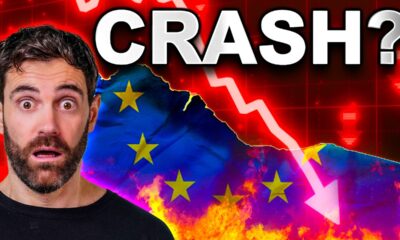







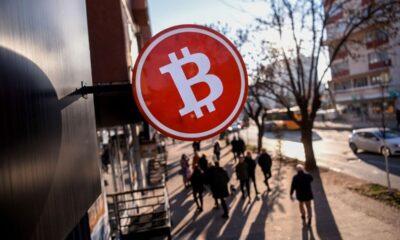



 ASTRO Price
ASTRO Price



